Larches are conifers in the genus Larix. Growing from 20 to 45 m (66 to 148 ft) tall, they are native to much of the cooler temperate northern hemisphere, on lowlands in the north and high on mountains further south. The leaves (light green) are needle-like, 2 – 5 centimetres long and slender. Larches are among the few deciduous conifers. The root systems are broad and deep and the bark is finely cracked and wrinkled in irregular plaques. Usually grown for use in the building of houses.
Larches are frequently used in bonsai culture where their knobby bark, small needles, fresh spring foliage, and autumn colour are features much admired. European larch, Larix decidua; Japanese larch, Larix kaempferi and Tamarack larch, Larix larcina are the varieties most commonly trained as bonsai. Their only serious weakness as far as bonsai is concerned is their tendency to lose branches for no apparent reason.
They are a must for any collector, easily trained and offering a pleasing image, even as a tiny plant. As an older tree, the larch is outstanding in the quality of age it can convey as bonsai. Overall, it is a very easy and rewarding tree as bonsai.
Larches are prone to the fungal canker disease Lachnellula; this is particularly a problem on sites prone to late spring frosts, which cause minor injuries to the tree allowing entry to the fungal spores, causing internal wood rot not immediately obvious to the human eye.
The European larch being extremely popular, with many unique specimens found in Europe, they are readily available and are often used to create forest groups. They are liked for their dramatic change in the appearance of the foliage through the seasons. Its small cones that appear in spring are usually purple in colour before browning and persisting on the tree for a number of years before dropping.
Larix Decidua. European Larch:The European larch (Larix decidua) is one of the few deciduous conifers. It is a long-lived and fast-growing tree, native to the mountains of central Europe, the Alps and Carpathian Mountains; it is found also in lowland areas in northern Poland and southern Lithuania.
A medium to large deciduous coniferous tree reaching 25m, with a trunk up to 1 m diameter, the crown is conic when young, becoming broad with age; the main branches are level to upswept, with the side branches often pendulous. The shoots are dimorphic, with growth divided into long shoots and bearing several buds. The leaves are needle-like, light green, which turn bright yellow before they fall in the autumn, leaving the pale yellow-buff shoots bare until the next spring.
It is cold tolerant, able to survive very low winter temperatures. It only grows on well-drained soils, avoiding waterlogged ground and is not shade tolerant.


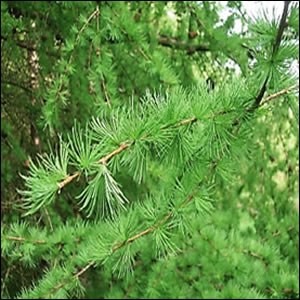

Larix kaempferi - Japanese larch:
This is a species of larch native to Japan, mostly in the mountains of Chūbu and Kantō regions in central Honshū
It is a medium-sized to large deciduous coniferous tree reaching 40 m in height, with a trunk up to 1 m diameter. The crown is broad conic; both the main branches and the side branches are level, the side branches only rarely drooping. The leaves are needle-like, light glaucous green, 2 – 5 cm long; they turn bright yellow to orange before they fall in the autumn.
Japanese larch is an important tree in forestry plantations, being grown throughout central and northern Japan and also widely in northern Europe, particularly the British Isles. The wood is tough and durable, used for general construction work. Larch poles are widely used for fencing.
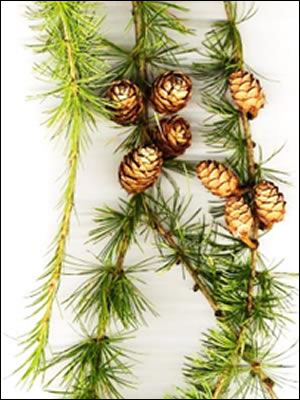
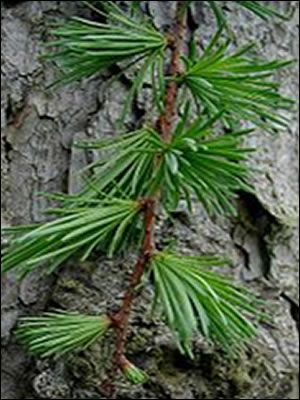
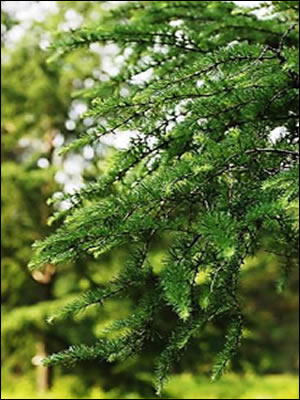
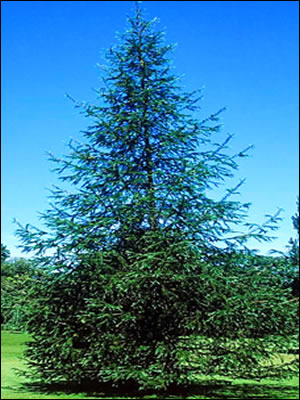
Larix larcina - American larch:
It is a small to medium-size deciduous tree reaching 20 metres in height with a trunk up to 60 cms. The bark is tight and flaky, pink, but under flaking bark it can appear reddish. The leaves are needle-like, 2 – 3 cm short, light blue-green, turning bright yellow before they fall in the autumn, leaving the pale pinkish-brown shoots bare until the next spring. The needles are produced spirally on long shoots and in dense clusters on long woody spur shoots. The cones are the smallest of any larch, only 1 cm long, with 12 - 25 seed scales; they are bright red, turning brown and opening to release the seeds when mature, 4 to 6 months after pollination.
- The needles are normally borne on a short shoot in groups of 10 – 20 needles.
- The larch is deciduous and the needles turn yellow in autumn.
- The seed cones are small, less than 2 cm long, with lustrous brown scales.
- They are commonly found in swamps, bogs, and other low-land areas.
They are very cold tolerant, able to survive temperatures down to at least -25°C and often occur at the arctic tree line on the edge of the tundra. They can tolerate a wide range of soil conditions but grows most commonly in wet to moist organic soils such as sphagnum peat and woody peat. The tree is found on mineral soils that range from heavy clay to coarse sand; thus texture does not seem to be limiting. They can grow well on calcareous soils.
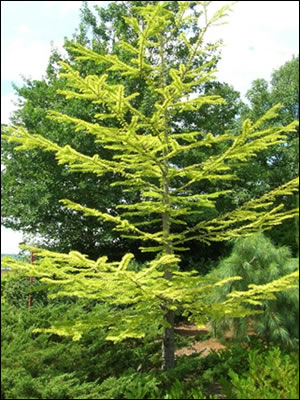


- Place in a sunny position; however, ensure leaves do not scorch in full summer sun; this can be caused by a lack of moisture at the roots, Larches will also grow well in semi-shade. They are extremely hardy, not requiring winter protection until temperatures drop below -20°C. If heavily wired they may be less hardy.
- Larches produce shorter, more compact needles in cooler climates similar to their native habitat; in hot and humid conditions their needles will grow longer.
- Keep evenly moist. Larch kept in full sun during summer can become very thirsty. In hard-water areas try to use rainwater or administer a fortnightly dose of ericaceous fertiliser to stop the soil becoming too alkaline.
- Feed heavily as soon as buds appear in spring with a high nitrogen feed to force vigorous growth; this should be reduced for finished trees that require only fine growth. Continue to feed well until mid-summer when the tree will enter a semi-dormant period. From late summer onwards, revert to a low-nitrogen feed to strengthen the tree for the coming winter.
- Larches do not like being pot-bound and need repotting annually or bi-annually in spring as buds extend. Do not bare-root and do not root prune heavily.
- Hard pruning is best carried out in late winter. Larches need serious pruning at this time of year to retain their shape.
- Maintenance pruning should be carried out through the year by pinching back new shoots; allow new growth to extend first before pinching back as will allow the branches and trunk to thicken. Larches are very vigorous and can replace newly pruned growth within a matter of weeks. Always remove buds growing in branch forks.
- Larches are best wired in the spring when the leaf buds are ready to sprout and the bare branches can still be seen; care should be taken not to knock off new buds. Larch branches thicken rapidly and wire should inspected regularly to ensure it is not cutting in. Old branches can be successfully wired though if the bark is rough, it can mark easily and the use of guy wires is preferable.
- The species can be styled to many styles - formal, informal, leaning, windswept, driftwood, literati, semi-cascade, raft, root-connected, twin trunk, triple trunk, group and miniature bonsai — larch is versatile!!
- Adelgids are the most common pests. The ones that attack larch are covered with white woolly wax and are associated with honeydew and sooty moulds. Treatment is by contact spray using Malathion. A winter spray with dormant oil will take care of any over wintering insects.
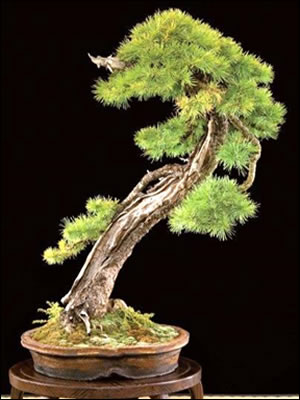

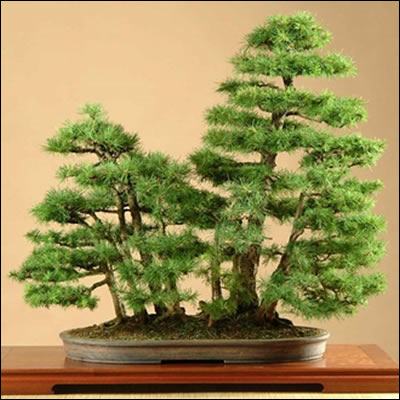


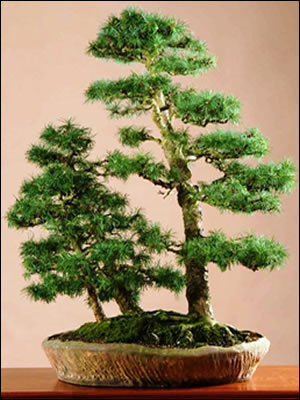
Web design: nysys